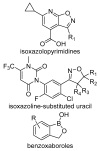Current Status and Future Prospects in Herbicide Discovery
- PMID: 31514265
- PMCID: PMC6783942
- DOI: 10.3390/plants8090341
Current Status and Future Prospects in Herbicide Discovery
Abstract
Herbicides represent about 60% of the pesticides (by volume) used worldwide. The success of herbicides can be attributed in part to a relatively steady discovery of one unique mechanisms of action (MOA) every two years from the early 1950s to the mid-1980s. While this situation changed dramatically after the introduction of glyphosate-resistant crops, evolution of resistance to glyphosate has renewed the agrichemical industry interest in new chemistry interacting with novel target sites. This review analyses recent characterization of new herbicide target sites, the chemical classes developed to inhibit these target sites, and where appropriate the innovative technologies used in these discovery programs.
Keywords: amino acid biosynthesis; lipid biosynthesis; mechanism of action; plastoquinone biosynthesis; pyrimidine biosynthesis; target site.
Conflict of interest statement
The author declares no conflict of interest.
Figures
















Similar articles
-
C-P Natural Products as Next-Generation Herbicides: Chemistry and Biology of Glufosinate.J Agric Food Chem. 2020 Mar 18;68(11):3344-3353. doi: 10.1021/acs.jafc.0c00052. Epub 2020 Mar 9. J Agric Food Chem. 2020. PMID: 32125843
-
Glyphosate: a once-in-a-century herbicide.Pest Manag Sci. 2008 Apr;64(4):319-25. doi: 10.1002/ps.1518. Pest Manag Sci. 2008. PMID: 18273882 Review.
-
Taking stock of herbicide-resistant crops ten years after introduction.Pest Manag Sci. 2005 Mar;61(3):211-8. doi: 10.1002/ps.1024. Pest Manag Sci. 2005. PMID: 15660452 Review.
-
Overview of glyphosate-resistant weeds worldwide.Pest Manag Sci. 2018 May;74(5):1040-1049. doi: 10.1002/ps.4760. Epub 2017 Nov 29. Pest Manag Sci. 2018. PMID: 29024306 Review.
-
Why have no new herbicide modes of action appeared in recent years?Pest Manag Sci. 2012 Apr;68(4):505-12. doi: 10.1002/ps.2333. Epub 2011 Dec 22. Pest Manag Sci. 2012. PMID: 22190296
Cited by
-
Transformative Approaches for Sustainable Weed Management: The Power of Gene Drive and CRISPR-Cas9.Genes (Basel). 2023 Dec 4;14(12):2176. doi: 10.3390/genes14122176. Genes (Basel). 2023. PMID: 38136999 Free PMC article. Review.
-
The silver bullet that wasn't: Rapid agronomic weed adaptations to glyphosate in North America.PNAS Nexus. 2023 Dec 5;2(12):pgad338. doi: 10.1093/pnasnexus/pgad338. eCollection 2023 Dec. PNAS Nexus. 2023. PMID: 38059262 Free PMC article.
-
Inhibition of chloroplast translation as a new target for herbicides.RSC Chem Biol. 2021 Nov 10;3(1):37-43. doi: 10.1039/d1cb00192b. eCollection 2022 Jan 5. RSC Chem Biol. 2021. PMID: 35128407 Free PMC article.
-
The continuing significance of chiral agrochemicals.Pest Manag Sci. 2025 Apr;81(4):1697-1716. doi: 10.1002/ps.8655. Epub 2025 Jan 17. Pest Manag Sci. 2025. PMID: 39821341 Free PMC article. Review.
-
(E)-6-(Furan-2-yl-methyl-idene)-6,7,8,9-tetra-hydro-pyrido[2,1-b]quinazoline-11-thione.IUCrdata. 2020 Mar 13;5(Pt 3):0. doi: 10.1107/S2414314620003569. eCollection 2020 Mar. IUCrdata. 2020. PMID: 36339479 Free PMC article.
References
-
- Sterling T.M., Hall J.C. Mechanism of action of natural auxins and the auxinic herbicides. In: Roe R.M., Burton J.D., Kuhr R.J., editors. Herbicide Activity: Toxicology, Biochemistry and Molecular Biology. IOS Press; Amsterdam, The Netherlands: 1997. pp. 111–141.
-
- Pannell D.J., Tillie P., Rodríguez-Cerezo E., Ervin D., Frisvold G.B. Herbicide resistance: Economic and environmental challenges. AgBioForum. 2017;19:136–155.
-
- Shaw D.R. The “Wicked” nature of the herbicide resistance problem. Weed Sci. 2016;64:552–558. doi: 10.1614/WS-D-15-00035.1. - DOI
-
- Ervin D.E., Breshears E.H., Frisvold G.B., Hurley T., Dentzman K.E., Gunsolus J.L., Jussaume R.A., Owen M.D.K., Norsworthy J.K., Al Mamun M.M., et al. Farmer attitudes toward cooperative approaches to herbicide resistance management: A common pool ecosystem service challenge. Ecol. Econ. 2019;157:237–245. doi: 10.1016/j.ecolecon.2018.11.023. - DOI
Publication types
LinkOut - more resources
Full Text Sources
Other Literature Sources

